As shown by our slipshod, tongue-twisting title, slopes can be very “brittle”.
We demonstrate how to convert the slopes of the sides of a triangle from a geometric sequence to an arithmetic sequence. Hopefully it makes sense.
Modified midpoint theorem
A line which connects the midpoints of two sides of a triangle is parallel to the third side and its length is half of the third side’s length. So says the midpoint theorem.
Since a midpoint amounts to dividing a line segment in the ratio ![]() , we’ll modify this slightly for our triangle and rather divide the sides in the
, we’ll modify this slightly for our triangle and rather divide the sides in the ![]() atio
atio ![]() , whe
, whe![]() e
e ![]() .
.
In ![]() , let
, let ![]() and
and ![]() be points on
be points on ![]() and
and ![]() which divide the sides in the ratio
which divide the sides in the ratio ![]() , where
, where ![]() is a positive integer. PROVE that the line segment
is a positive integer. PROVE that the line segment ![]() is parallel to
is parallel to ![]() and that
and that ![]() .
.
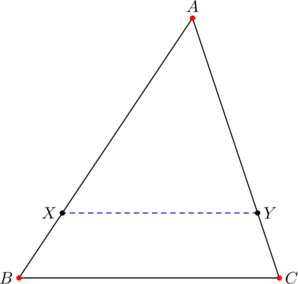
In the diagram above, ![]() and
and ![]() . If we place the vertices of
. If we place the vertices of ![]() at
at ![]() ,
, ![]() , and
, and ![]() , then we can obtain the coordinates of points
, then we can obtain the coordinates of points ![]() and
and ![]() using the formula for internal division of a line segment:
using the formula for internal division of a line segment:
![]()
The slope of line segment ![]() is:
is:
![Rendered by QuickLaTeX.com \begin{equation*} \begin{split} &=\left[\frac{y_1+ny_2}{n+1}-\left(\frac{y_1+ny_3}{n+1}\right)\right]\div\left[\frac{x_1+nx_2}{n+1}-\left(\frac{x_1+nx_3}{n+1}\right)\right]\\ &=\frac{n}{n+1}(y_2-y_3)\div\left(\frac{n}{n+1}(x_2-x_3)\right)\\ &=\frac{y_2-y_3}{x_2-x_3} \end{split} \end{equation*}](https://blog.fridaymath.com/wp-content/ql-cache/quicklatex.com-45f2a8712f701504e7f906c7b8d185b8_l3.png)
So ![]() is parallel to
is parallel to ![]() . In addition we obtain
. In addition we obtain ![]() .
.
Easy-peasy.
Derailing development
If we apply the above idea to our own triangle, look what we get.
Suppose that ![]() has vertices
has vertices ![]() ,
, ![]() ,
, ![]() , and slopes
, and slopes ![]() for sides
for sides ![]() , respectively. For
, respectively. For ![]() , find coordinates for the point which divides
, find coordinates for the point which divides ![]() in the ratio
in the ratio ![]() .
.
Note the “direction” of the division. The desired point will be ![]() , using the formula for internal division of a line segment. In view of the
, using the formula for internal division of a line segment. In view of the ![]() elationship among the coordinates, this becomes
elationship among the coordinates, this becomes
![]()
You see that quadratic rearing its beautiful head again?
Suppose that ![]() has vertices
has vertices ![]() ,
, ![]() ,
, ![]() , and slopes
, and slopes ![]() for sides
for sides ![]() , respectively. For
, respectively. For ![]() , find coordinates for the point which divides
, find coordinates for the point which divides ![]() in the ratio
in the ratio ![]() .
.
Ordinarily, this would be the point ![]() . Using the
. Using the ![]() elationship among the coordinates, we get
elationship among the coordinates, we get
![]()
Suppose that ![]() has vertices
has vertices ![]() ,
, ![]() ,
, ![]() , and slopes
, and slopes ![]() for sides
for sides ![]() , respectively. For
, respectively. For ![]() , find coordinates for the point which divides
, find coordinates for the point which divides ![]() in the ratio
in the ratio ![]() .
.
This would be the point ![]() . The
. The ![]() elationship among the coordinates then gives
elationship among the coordinates then gives
![]()
(Main goal)
Suppose that ![]() has vertices
has vertices ![]() ,
, ![]() ,
, ![]() , and slopes
, and slopes ![]() for sides
for sides ![]() , respectively. For
, respectively. For ![]() , PROVE that there is a point
, PROVE that there is a point ![]() on
on ![]() , a point
, a point ![]() on
on ![]() , and a point
, and a point ![]() on
on ![]() such that the slopes of the sides of
such that the slopes of the sides of ![]() form an arithmetic progression.
form an arithmetic progression.
Basically, the side-slopes form a geometric progression, while the sub-triangle’s side-slopes form an arithmetic progression. Fo![]() . Any.
. Any. ![]() .
.
Let ![]() be the point which divides
be the point which divides ![]() in the ratio
in the ratio ![]() , let
, let ![]() be the point which divides
be the point which divides ![]() in the ratio
in the ratio ![]() , and let
, and let ![]() be the point which divides
be the point which divides ![]() in the ratio
in the ratio ![]() . As in the three preceding examples, these points are:
. As in the three preceding examples, these points are:
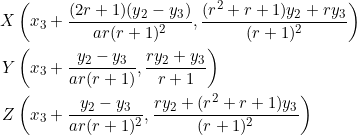
By the modified midpoint theorem, ![]() would be parallel to
would be parallel to ![]() , so its slope is
, so its slope is ![]() (alternatively can be confirmed by direct calculation). Similarly,
(alternatively can be confirmed by direct calculation). Similarly, ![]() would be parallel to
would be parallel to ![]() , so its slope is
, so its slope is ![]() .
.
By direct calculation, the slope of ![]() is
is ![]() .
.
Thus, the slopes of the sides of ![]() are
are ![]() , an arithmetic progression.
, an arithmetic progression.
Given ![]() with vertices at
with vertices at ![]() ,
, ![]() , and
, and ![]() , find coordinates for points
, find coordinates for points ![]() on
on ![]() such that the slopes of
such that the slopes of ![]() are
are ![]() .
.
Observe that the slopes of sides ![]() are
are ![]() , respectively.
, respectively.
Thus, by Example 5, let ![]() be the point which divides
be the point which divides ![]() in the ratio
in the ratio ![]() , let
, let ![]() be the point which divides
be the point which divides ![]() in the ratio
in the ratio ![]() , and let
, and let ![]() be the point which divides
be the point which divides ![]() in the ratio
in the ratio ![]() . Lots of repetitions there
. Lots of repetitions there ![]() .
.
Using the formula for internal division of a line segment, we find these points to be ![]() ,
, ![]() , and
, and ![]() . Then:
. Then:

Given ![]() with vertices at
with vertices at ![]() ,
, ![]() , and
, and ![]() , find coordinates for points
, find coordinates for points ![]() on
on ![]() such that the slopes of
such that the slopes of ![]() are
are ![]() .
.
In this case, the slopes of sides ![]() are
are ![]() , respectively. A geometric progression in which
, respectively. A geometric progression in which ![]() .
.
By Example 5, let ![]() divide each of the three sides
divide each of the three sides ![]() in the ratio
in the ratio ![]() .
.
Using the formula for internal division of a line segment, we find these points to be ![]() ,
, ![]() , and
, and ![]() .
.

Given ![]() with vertices at
with vertices at ![]() ,
, ![]() , and
, and ![]() , find coordinates for (external) points
, find coordinates for (external) points ![]() on
on ![]() such that the slopes of
such that the slopes of ![]() are
are ![]() .
.
Observe that the slopes of sides ![]() are
are ![]() , respectively. They form a geometric progression in which
, respectively. They form a geometric progression in which ![]() .
.
Let ![]() be points which divide
be points which divide ![]() all in the ratio
all in the ratio ![]() . We obtain the external points
. We obtain the external points ![]() ,
, ![]() , and
, and ![]() . Then:
. Then:

The scene here may be worth seeing ![]()
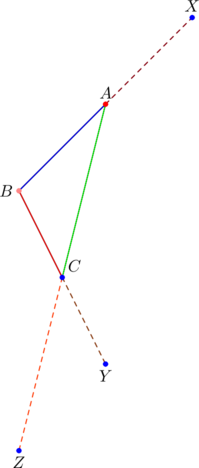
Notice that ![]() is the midpoint of both
is the midpoint of both ![]() and
and ![]() , while
, while ![]() is the midpoint of
is the midpoint of ![]() . It follows that the length of
. It follows that the length of ![]() is twice that of
is twice that of ![]() .
.
Touching negative common ratios, a couple of strangely exciting things happen. This is why we’ve been silent about them in many of our posts, but we have them on our radar and will treat them later.
Let ![]() be a right isosceles triangle with slopes
be a right isosceles triangle with slopes ![]() . PROVE that there are two points
. PROVE that there are two points ![]() and
and ![]() on sides
on sides ![]() such that the slope of the line segment
such that the slope of the line segment ![]() is
is ![]() times the slope of
times the slope of ![]() .
.
By Example 5, we can find points ![]() such that the slopes of the sides of
such that the slopes of the sides of ![]() are
are ![]() .
.
Using the fact that ![]() for a right isosceles triangle, we have:
for a right isosceles triangle, we have:
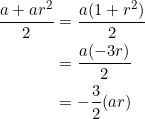
Plus or minus two
Let ![]() be an equilateral triangle with slopes
be an equilateral triangle with slopes ![]() . PROVE that there are two points
. PROVE that there are two points ![]() and
and ![]() on two sides such that the slope of the line segment
on two sides such that the slope of the line segment ![]() is
is ![]() .
.
By Example 5, we can find points ![]() on
on ![]() such that the slopes of the sides of
such that the slopes of the sides of ![]() are
are ![]() .
.
Using the fact that ![]() and
and ![]() for an equilateral triangle, we have:
for an equilateral triangle, we have:
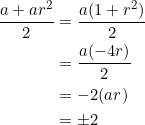
Point-blank.
Takeaway
The construction we’ve done is just a variant of the medial triangle. Unlike the medial triangle, ours is different in the sense that it does not retain the slopes of the parent triangle. While the slopes of the parent triangle form a geometric progression, its own slopes form an arithmetic progression. Talk about t![]() ansfo
ansfo![]() mation.
mation.
Tasks
- (Two out) Consider
 with vertices at
with vertices at  ,
,  , and
, and  . PROVE that one can obtain the infinite arithmetic sequence
. PROVE that one can obtain the infinite arithmetic sequence  as slopes of line segments drawn from vertex
as slopes of line segments drawn from vertex  to side
to side  .
.
(Notice that is out because it’s already the slope of side
is out because it’s already the slope of side  . Other than that, every other integer can be obtained this way. What’s somewhat interesting here is that the line segments from
. Other than that, every other integer can be obtained this way. What’s somewhat interesting here is that the line segments from  to
to  that generate the sequence terms all stay within the triangle; none of them is external.)
that generate the sequence terms all stay within the triangle; none of them is external.) - (Fibonacci sequence) Explain how the terms of a Fibonacci sequence
 can be generated as slopes.
can be generated as slopes. - (Always odd) Let
 be a positive integer, and consider
be a positive integer, and consider  with vertices at
with vertices at  ,
,  , and
, and  . PROVE that there is a point
. PROVE that there is a point  on
on  and a point
and a point  on
on  such that the slope of the line segment
such that the slope of the line segment  is
is  .
.
(If is an integer, then any number of the form
is an integer, then any number of the form  is odd.)
is odd.) - Let
 be such that sides
be such that sides  have slopes
have slopes  . Let
. Let  be points on
be points on  which divide these sides all in the ratio
which divide these sides all in the ratio  . PROVE that:
. PROVE that:
- the
 -coordinates of
-coordinates of  form an arithmetic progression
form an arithmetic progression - the line connecting the centroid of
 to the centroid of
to the centroid of  is parallel to side
is parallel to side  .
.
- the
- Find an appropriate choice of coordinates for the vertices of a right isosceles triangle whose side-slopes form a geometric progression.